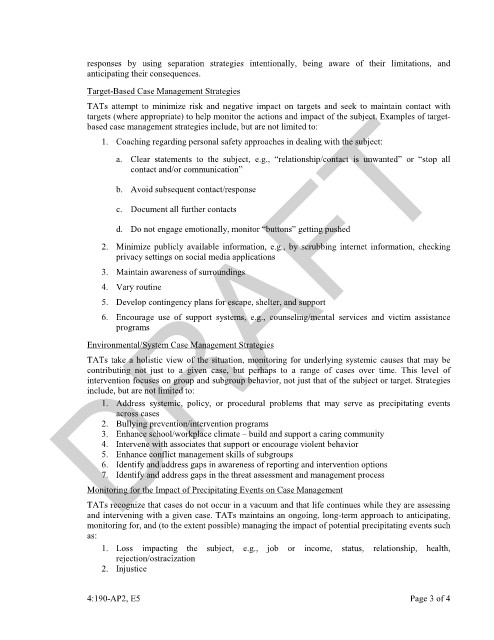Page 887 - draft
P. 887
responses by using separation strategies intentionally, being aware of their limitations, and
anticipating their consequences.
Target-Based Case Management Strategies
DRAFT
TATs attempt to minimize risk and negative impact on targets and seek to maintain contact with
targets (where appropriate) to help monitor the actions and impact of the subject. Examples of target-
based case management strategies include, but are not limited to:
1. Coaching regarding personal safety approaches in dealing with the subject:
a. Clear statements to the subject, e.g., “relationship/contact is unwanted” or “stop all
contact and/or communication”
b. Avoid subsequent contact/response
c. Document all further contacts
d. Do not engage emotionally, monitor “buttons” getting pushed
2. Minimize publicly available information, e.g., by scrubbing internet information, checking
privacy settings on social media applications
3. Maintain awareness of surroundings
4. Vary routine
5. Develop contingency plans for escape, shelter, and support
6. Encourage use of support systems, e.g., counseling/mental services and victim assistance
programs
Environmental/System Case Management Strategies
TATs take a holistic view of the situation, monitoring for underlying systemic causes that may be
contributing not just to a given case, but perhaps to a range of cases over time. This level of
intervention focuses on group and subgroup behavior, not just that of the subject or target. Strategies
include, but are not limited to:
1. Address systemic, policy, or procedural problems that may serve as precipitating events
across cases
2. Bullying prevention/intervention programs
3. Enhance school/workplace climate – build and support a caring community
4. Intervene with associates that support or encourage violent behavior
5. Enhance conflict management skills of subgroups
6. Identify and address gaps in awareness of reporting and intervention options
7. Identify and address gaps in the threat assessment and management process
Monitoring for the Impact of Precipitating Events on Case Management
TATs recognize that cases do not occur in a vacuum and that life continues while they are assessing
and intervening with a given case. TATs maintains an ongoing, long-term approach to anticipating,
monitoring for, and (to the extent possible) managing the impact of potential precipitating events such
as:
1. Loss impacting the subject, e.g., job or income, status, relationship, health,
rejection/ostracization
2. Injustice
4:190-AP2, E5 Page 3 of 4

